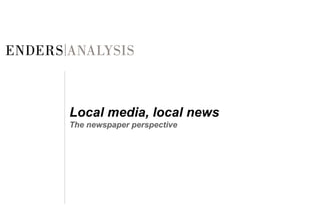Local Newspaper Economics
•Download as PPT, PDF•
10 likes•1,421 views
Good slides from Douglas McCabe of Enders Analyis presented to #cabinet or c&bnet event on hyperlocal news hosted by Sion simon MP in London UK. William Perrin and Rachel Sterne co-chaired
Report
Share
Report
Share

Recommended
Fire Kills and Ebbsfleet | October 2014

Fire Kills and Ebbsfleet | October 2014Department for Communities and Local Government Local Digital Campaign
More Related Content
What's hot
Fire Kills and Ebbsfleet | October 2014

Fire Kills and Ebbsfleet | October 2014Department for Communities and Local Government Local Digital Campaign
What's hot (20)
Selection of 2008 UK Digital consumer and advertising trends

Selection of 2008 UK Digital consumer and advertising trends
'The UK Commercial Radio Industry' by Tom Andrews, Henry Devereux, Grant Goddard

'The UK Commercial Radio Industry' by Tom Andrews, Henry Devereux, Grant Goddard
The Cinema Exhibitor’s Association Annual Report 2011

The Cinema Exhibitor’s Association Annual Report 2011
European publishers, the digital advertising industry and direct marketers ex...

European publishers, the digital advertising industry and direct marketers ex...
20101020 Broadband in Europe - Internet Hungary conference

20101020 Broadband in Europe - Internet Hungary conference
Uk fm in offices and commercial buildings 31 dec 2020

Uk fm in offices and commercial buildings 31 dec 2020
Viewers also liked
Viewers also liked (10)
Similar to Local Newspaper Economics
Iain Bennett DCMS - 13 04 30 ultra connected cities seminar

Iain Bennett DCMS - 13 04 30 ultra connected cities seminarIndependent Networks Co-operative Association
Similar to Local Newspaper Economics (20)
Introduction to hyper local media, part one: audience data, definitions and U...

Introduction to hyper local media, part one: audience data, definitions and U...
Key insights on broadcasting & digital media david mc munn

Key insights on broadcasting & digital media david mc munn
Introduction to hyper local media: full 12 inch version

Introduction to hyper local media: full 12 inch version
Hyper local update: 20 key developments, December 2010 - January 2011

Hyper local update: 20 key developments, December 2010 - January 2011
Iain Bennett DCMS - 13 04 30 ultra connected cities seminar

Iain Bennett DCMS - 13 04 30 ultra connected cities seminar
SEMPL20 - ANDRAŽ ZORKO, Partner and Director, Valicon ALEKSANDER BRATINA, D...

SEMPL20 - ANDRAŽ ZORKO, Partner and Director, Valicon ALEKSANDER BRATINA, D...
'Response By UKRD Group Limited To United Kingdom Government Department For C...

'Response By UKRD Group Limited To United Kingdom Government Department For C...
More from william perrin
More from william perrin (20)
Intro to 360giving - BOND Transparency working group

Intro to 360giving - BOND Transparency working group
Design Council Sounding Board - digital provocation

Design Council Sounding Board - digital provocation
Neighbourhood News - interim outcomes #mediaplurality14

Neighbourhood News - interim outcomes #mediaplurality14
Local media in the UK - a more co-operative approach

Local media in the UK - a more co-operative approach
Basic digital high street through to augmented reality

Basic digital high street through to augmented reality
William perrin guardian mobile business summit 2012

William perrin guardian mobile business summit 2012
Augmented Reality demo slides for Destination Local at NESTA from Talk About ...

Augmented Reality demo slides for Destination Local at NESTA from Talk About ...
Using the web in tackling anti social behaviour - Baroness Newlove seminar

Using the web in tackling anti social behaviour - Baroness Newlove seminar
Recently uploaded
Unveiling Falcon Invoice Discounting: Leading the Way as India's Premier Bill...

Unveiling Falcon Invoice Discounting: Leading the Way as India's Premier Bill...Falcon Invoice Discounting
Recently uploaded (20)
Lundin Gold - Q1 2024 Conference Call Presentation (Revised)

Lundin Gold - Q1 2024 Conference Call Presentation (Revised)
SEO Case Study: How I Increased SEO Traffic & Ranking by 50-60% in 6 Months

SEO Case Study: How I Increased SEO Traffic & Ranking by 50-60% in 6 Months
New 2024 Cannabis Edibles Investor Pitch Deck Template

New 2024 Cannabis Edibles Investor Pitch Deck Template
joint cost.pptx COST ACCOUNTING Sixteenth Edition ...

joint cost.pptx COST ACCOUNTING Sixteenth Edition ...
Marel Q1 2024 Investor Presentation from May 8, 2024

Marel Q1 2024 Investor Presentation from May 8, 2024
Unveiling Falcon Invoice Discounting: Leading the Way as India's Premier Bill...

Unveiling Falcon Invoice Discounting: Leading the Way as India's Premier Bill...
Ooty Call Gril 80022//12248 Only For Sex And High Profile Best Gril Sex Avail...

Ooty Call Gril 80022//12248 Only For Sex And High Profile Best Gril Sex Avail...
Lucknow Housewife Escorts by Sexy Bhabhi Service 8250092165

Lucknow Housewife Escorts by Sexy Bhabhi Service 8250092165
The Abortion pills for sale in Qatar@Doha [+27737758557] []Deira Dubai Kuwait![The Abortion pills for sale in Qatar@Doha [+27737758557] []Deira Dubai Kuwait](data:image/gif;base64,R0lGODlhAQABAIAAAAAAAP///yH5BAEAAAAALAAAAAABAAEAAAIBRAA7)
![The Abortion pills for sale in Qatar@Doha [+27737758557] []Deira Dubai Kuwait](data:image/gif;base64,R0lGODlhAQABAIAAAAAAAP///yH5BAEAAAAALAAAAAABAAEAAAIBRAA7)
The Abortion pills for sale in Qatar@Doha [+27737758557] []Deira Dubai Kuwait
QSM Chap 10 Service Culture in Tourism and Hospitality Industry.pptx

QSM Chap 10 Service Culture in Tourism and Hospitality Industry.pptx
Pre Engineered Building Manufacturers Hyderabad.pptx

Pre Engineered Building Manufacturers Hyderabad.pptx
Challenges and Opportunities: A Qualitative Study on Tax Compliance in Pakistan

Challenges and Opportunities: A Qualitative Study on Tax Compliance in Pakistan
Kalyan Call Girl 98350*37198 Call Girls in Escort service book now

Kalyan Call Girl 98350*37198 Call Girls in Escort service book now
Al Mizhar Dubai Escorts +971561403006 Escorts Service In Al Mizhar

Al Mizhar Dubai Escorts +971561403006 Escorts Service In Al Mizhar
Horngren’s Cost Accounting A Managerial Emphasis, Canadian 9th edition soluti...

Horngren’s Cost Accounting A Managerial Emphasis, Canadian 9th edition soluti...
Local Newspaper Economics
- 1. Local media, local news The newspaper perspective
- 2. [Source: ABC] Newspaper consumption trends Year-on-year change in daily newspaper purchases (%) Regional newspaper circulation declines are steeper than for national titles
